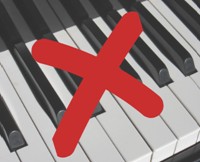
Every piano student hears “practice your scales” from their instructor. Even though there’s merit in studying scales,in and of itself isn’t enough. It’s certainly not very musical and doesn’t really teach you to play songs.
I’m not suggesting that you ignore scales. I especially encourage you to learn the Major scales (or Major keys of music as I prefer to call them).
But let’s look beyond them so we can utilize them to create music.
A Major Scale (or key of music) is a pattern of 7 different notes.

As you can see from the illustration, each tone has a corresponding number. This is also known as the number system.
Each tone also has a corresponding chord. These chords are also known as diatonic harmony. Diatonic simply means “in the key”. In the case of a key of music, you have 7 different chords.







The purpose of these diatonic chords are to harmonize these 7 different notes.
But you only need 3 of these chords. These 3 chords are referred to as the primary chords. They’re also known as triads because they contain 3 notes (tri meaning 3).
They’re built upon the 1st, 4th and 5th tones in the key. Roman numerals are used to notate them.



So why are these particular chords used to harmonize these 7 notes?
It’s a very simple concept to understand. These chords have common tones. In other words, they have tones within them that are common to one or more of these 3 primary chords.
A diatonic chord will harmonize any melody note that also exists within the chord. You’ll find that you can also have more than one chord to harmonize a melody note.
Diatonic triad Harmonization
| Number | Melody Note | Harmonizing Chord(s) | Chord Tones | Common Tone in Chord |
| 1 | C | C Major & F Major | C-E-G & F-A-C | C |
| 2 | D | G Major | G-B-D | D |
| 3 | E | C Major | C-E-G | E |
| 4 | F | F Major | F-A-C | F |
| 5 | G | C Major & G Major | C-E-G & G-B-D | G |
| 6 | A | F Major | F-A-C | A |
| 7 | B | G Major | G-B-D | B |
C Harmonized with C Major & F Major


D Harmonized with G Major

E Harmonized with C Major

F Harmonized with F Major

G Harmonized with C Major & G Major


A Harmonized with F Major

B Harmonized with G Major

Now that I’ve shown you how any diatonic melody note can be harmonized with these three chords, where do triad scales come into play?
If we only play these triads in root position, we would be very limited playing them as triad scales.
This is where inversions come in. Any triad can be played in 3 different positions.
Root Position

First Inversion

Second Inversion

If you consider the top note of these triads as the melody, you have the essential knowledge to play triad scales.
So here are our triad scales:
We’ll start with C Major in first inversion (C on top).

…to G Major in root position (D on top)

…to C Major 2nd inversion (E on top)

…to F Major 1st inversion (F on top)

…to G Major 1st inversion (G on top)

…to F Major 2nd inversion (A on top)

…to G Major 2nd inversion (B on top)

The skill to play these triad scales requires the recognition of the primary chords as well as their root positions and inversions. When you’re proficient enough at playing triad scales, it will give you the skill to harmonize melodies as well as more advanced chords.
The structure of Triad Scales
Although I’ve shared these triad scales with you in the key of C Major, the structure of them is exactly the same in every Major key.
So here are the primary chords by number for triad scales:
1 5 1 4 1 4 5
Because Roman numerals are used to denote chords in the number system I’ll present them in this form also:
I V I IV I IV V
The Structure of Triad Scales in any Major Key
| Tone | Chord | Structure | Position |
| 1 | I | 3-5-R | 1st Inversion |
| 2 | V | R-3-5 | Root Position |
| 3 | I | 5-R-3 | 2nd Inversion |
| 4 | IV | 3-5-R | 1st Inversion |
| 5 | I | R-3-5 | Root Position |
| 6 | IV | 5-R-3 | 2nd Inversion |
| 7 | V | 5-R-3 | 2nd Inversion |
* The word tone is used interchangeably with the note or scaled degree
You can also play these triad scales in reverse just as you would single note scales. The goal is to learn to play them fluidly in all 12 Major keys. And even though this isn’t the only option to harmonize these 7 notes, it’s very powerful to play chords and opens the door to developing proficiency in playing more advanced chords.
Until next time, Go Play!
Greg Lee
Latest posts by Greg Lee (see all)
- What is a minor/Major 7 Chord? - October 26, 2023
- 7 Chord Substitutions that Professionals Use - October 19, 2023
- 5 Simple Chord Tricks to Sound Amazing - October 5, 2023



